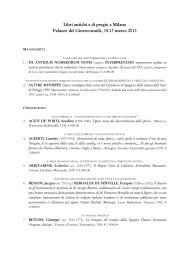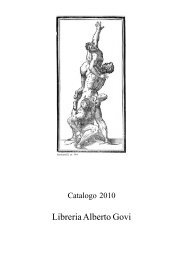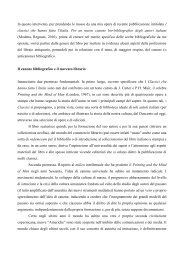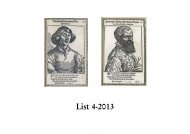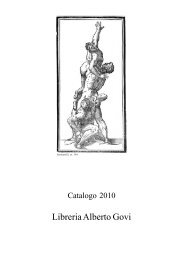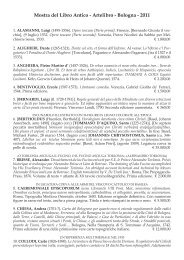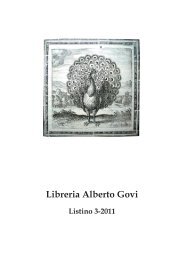trarch’s lyrics” (O.B. Hardison, Jr., Rhetoric, Poetic andthe Theory of Praise, in: “Landmark Essays on Rhetoricand Literature, 16”, C. Kallendorf, ed., Mahwah, N.J,1999, p. 92).In the second dialogue are also discussedthe different types of fiction: ‘La favola poi in tre partidividiamo & la prima chiamiamo vera che pero èfinta; la seconda finta che par vera, la terza quella cheessi fecero prima... Delle due prime ne nascono tuttii poemi ò pieni di verità, ò di ombra & imagine delvero. Pieni di verità dico quando s’abbraccia sotto favolaverità istorica, ò naturale ò morale secondo chedimostrerarsi. Ombra & imagine del vero poi é questafavola che é chia-mata imitatione, cioè narratione &isposizione di cose verisimili...’ (p. 63). “La première[fable], ‘vera, che pero è finta’, tire sa crédibilité de lavérité supérieure qui la motive. La seconde, ‘finta chepar vera’, est vraisemblable grâce à l’art de l’imitatioqui est propre du poète. Selon Alessandro Lionardi,ce dernier est ‘fingitore’ et ‘imitatore del vero’, il exerceses talents dans la fable en se servant à la fois dela vérité propre à l’historien, et de la vraisemblancecaractéristique de l’art oratoire... le genre entretientdonc des relations complexes avec les notions devérité et de vraisemblance: ces dernières montrentque la fable est à la frontière entre une pratique philosophique,une recherche et un dévoilement de laVérité transcendentale, et une pratique poétique quiest celle de l’imitatio vraisemblable” (V. Montagne,Antoine Héroët et ‘l’aultre invention extraicte de Platon’:remarques sur les inventions d’un poète-philosophe, in:“Bibliothèque d’Humanisme et Renaissance”, 64/3, 2004, p. 554).“I Tre discorsi (1553) di Girolamo Ruscelli (ca. 1515-1566) segnarono l’inizio della collaborazione di quest’ultimocon l’esordiente Plinio Pietrasanta, che era in realtà un semplice prestanome dietro il quale il Ruscelli pubblicòdiverse opere fino al 1555, quando fu chiamato in-sieme al Pietrasanta a presentarsi in tribunale per aver stampatosenza licenza un componimento osceno. Tale circostanza segnò la fine di questa collaborazione editoriale che videcoinvolto anche il bolognese Girolamo Giglio. Tuttavia, occorre sospendere il giudizio sulla collaborazione delRuscelli a un’edizione del Pietrasanta apparsa all’inizio del 1554, cioè i Dialogi di Messer Alessandro Lionardi, dellainventione poetica…” (P. Trovato, Con ogni diligenza corretto. La stampa e le revisioni editoriali dei testi letterari italiani,1470-1570, Bologna, 1991, p. 264).Nothing is known about the life of Alessandro Lionardi, a lawyer and poet from Padua and a pupil ofSperone Speroni. He left two volumes of Rime (1547, 1550) and the present treatise (cf. G. Vedova, Biografia degliscrittori padovani, Padova, 1832, I, pp. 513-515).Edit 16, CNCE45608; J. Balsamo, De Dante à Chiabrera. Poètes italiens de la Renaissance dans la bibliothèque de la FondationBarbier-Mueller, Genève, 2007, p. 441-442; G.J. Buelow, Music, Thetoric and the Concept of the Affections: A SelectiveBiography, in: “Notes”, 2 nd series, 30/2, 1973, p. 258; L. D. Green & J. J. Murphy, Renaissance Rhetoric Short Title Catalogue,1460-1700, (Aldershot, 2006), p. 274; B. Hathaway, Marvels and Commonplaces: Renaissance Literary Criticism,(New York, 1968), pp. 14-15, 191. € 950,00imitation of Vergil’s Bucolicae38) LORI, Andrea (ca. 1520-1579). Egloghe d’Andrea Lori, a imitation di Vergilio. Venezia, Gabriel Giolitode’ Ferrari e fratelli, 1554.12mo; later cardboards with inked title on front side (spine strenghened); 49, (1) ll. Printer’s device on the title-pageand the end. Some marks of use, margin somewhat narrow, but altogether a good copy from the library Galletti-Landau.FIRST EDITION dedicated to Abbot Ludovico Rucellai. In a letter to Alessandro Cini (dated Florence, October 25,1553) placed at the end of the volume, Lori begs his friend to present the work to the illustrious dedicatee, becausehe does not dare to send it directly; he then adds that Rucellai has been praised by him several times in the workunder the name of Anareto.The Egloghe a imitation di Vergilio are more than just a version in blank verse of the Bucolicae; due to numerouschanges in the text they are a rather accomplished imitation of Vergil’s work (P. Procaccioli, & D. Romei,Ludi esegetici: Berni, ‘Comento alla Primiera’ - Lasca, ‘Piangirida’ e ‘Comento di maestro Niccodemo sopra il Capitolo dellasalsiccia’, Rome, 2005, p. 239).Lori was born in Florence around 1520. About his life very little is known. But the facts which leaded to his- 42 -
death sentence issued against him on June 16, 1579, for a crimecommited by him together with the well known Venetian writerand publisher Celio Malespini are well documented. Actuallythey put up a fraud against the Florentine merchant Neri Guardi(who was beheaded in Rome in 1578) and the banker Rubertodi Filippo de’ Ricci, making counterfeit coupons and falsifyingbets. After their arrest, during the trial it also came out that Lori,in May 1578, had broken into the shop of Bartolommeo di NicolòBalsimelli da Settignano, stonecutter of S. Maria Maggiore, stealingprecious stones and alabasters of various colours. Lori washanged in Florence on July 4, 1579. Malespini, the same whoin 1580 will publish a pirate edition of the Gerusalemme Liberata,successfully avoided the sentence, escaping from town.After the death sentence had been pronounced, a false rumourspreaded that Lori had the life spared. In those days his friendGrazzini (called il Lasca) wrote some octaves in defence of Loriunder the title Scusatione per messer Andrea Lori.Lori had close relationships with many scholars of thetime such as Giovambattista Gelli, Benedetto Varchi, TommasoPorcacchi, Ludovico Dolce and, especially, Ludovico Domenichi,who repeatedly republished his translation of the Bucolicaetogether with Vergil’s other works (L’opere di Vergilio, Venezia,Farri, 1552). Several poems by Lori appeared in various contemporarylyrical anthologies. He also staged and edited the playFlora by L. Alamanni, writing the Intermezzi (Florence, L. Torrentino,1556). Two years before he had promoted the posthumousprinting of two plays by Lorenzo Comparini, Il Pellegrino,et il Ladro (Venice, G. Giolito, 1554) (cf. Dizionario Biografico degliItaliani, LXVI, 2007, by F. Pignatti).Edit 16, CNCE27087; Adams, L-1500; S. Bongi, Annali di GabrielGiolito de’ Ferrari, Roma 1890, I, pp. 422-425; C. Kallendorf, ABibliography of Renaissance Italian Translations of Vergil, (Firenze, 1954), p. 54; G. Mambelli, Annali delle edizioni virgiliane,(Firenze, 1954), p. 228, no. 999; A. Nuovo & Ch. Coppens, I Giolito e la stampa nell’Italia del XVI secolo, (Genève,2005),p. 496, no. 36; F.L.A. Schweiger, Handbuch der classischen Bibliographie, (Leipzig,m 1834), II.2, p. 1228. € 650,00the Papal conclave of April 155539) COPIE DES LETTRES missives, envoyées de Rome, traictans de l’election de Pape Marcel second, avec lapompe funebre de Pape Jules dernier decedé. Paris, Guillaume Guillard e Annet Brière, 1555.8vo. (6) leaves. Arms of Marcellus II. on the title-page. Boards, some very light dampstains, inner margins strengthened,a good copy.ORIGINAL FRENCH EDITION of this account of the funeral ceremony for pope Julius III (Gian Maria del Monte),who died on March 23, 1555 and of the ensuing conclave (April 4) in which cardinal Marcello Cervini was electedpope, although the emperor had instructed his cardinals to prevent his election. Contrary to custom, Cervini retainedhis old name of Marcello and was called Marcellus II and crowned on April 10, but without the customarysolemnity on account of the Lenten season. Desirous of inner reform of the Church he abolished abuses where everthey were found. He died after a reign of only twenty-two days, of a sickness resulting from overexertion duringthe pontifical functions of Holy Week and Easter. In his youth he had become private secretary to cardinal AlessandroFarnese, later one of the three presidents of the Council of Trent and in 1548 librarian of the Vatican library.BNF, notice FRBNF33327395 (lacking a leaf); another copy: Y. Sertenas issue, BNF, notice FRBNF33327396. € 250,00the Church Ordinance for the Duchy of Mecklenburg in Low German40) KERCKENORDENINGE: Wo ydt mit Christlyker Lere / vorrekinge der Sacramente / Ordination derDenere des Evangelij / ordentlyken Ceremonien / jn den Kercken / Visitation / Consistorio unde Scholen / ImHertochdome tho Mecklenborch / &c. geholden werdt. Rostock, Ludwig Dietz, 1557.4to. CXL leaves. Title printed in red and black, woodcut arms of the dukes of Mecklenburg on the title-page andon its verso, several leaves with musical notation. Wrappers, some very light browning and spots, but a fine copy.EXTREMELY RARE FIRST EDITION OF THE FIRST OFFICAL VERSION IN LOW GERMAN of the churchordinance for the Duchy of Mecklenburg.These ordinances addressed matters of church polity, administration, congregational life, charitable institutions,schools, the calendar, and worship and therefore effected a ‘revolution’ in social life. They go back tothe ancient city constitutions and that of Johann Aepinus for the Hanseatic city of Stralsund is regarded as thefirst Lutheran church order (1525) and were then followed by other German territorial and imperial cities, nota-- 43 -
- Page 1 and 2: Catalogue 2013Libreria Alberto Govi
- Page 3 and 4: Catalogue 2013Libreria Alberto Govi
- Page 5 and 6: an hitherto unknown philosophical m
- Page 7 and 8: ustica Lib. X., edited by Giorgio M
- Page 9 and 10: the end is furthermore printed the
- Page 11 and 12: without typographical data, but pro
- Page 13 and 14: Letteratura Italiana”, CXL, 1963,
- Page 15 and 16: as secondary only.The present two e
- Page 17 and 18: position as secretary at the court
- Page 19 and 20: From 1528 he was rector of the newl
- Page 21 and 22: famous personage was in high favor
- Page 23 and 24: Luigi Alamanni and Antonio Brucioli
- Page 25 and 26: In Pincio’s biography of Bernardo
- Page 27 and 28: Tempio della Fama; e così ne trass
- Page 29 and 30: power, and yet to make it possible
- Page 31 and 32: lini, Andrea Alciati, Lilio Gregori
- Page 33 and 34: phy in particular, was presented as
- Page 35 and 36: quale quello che lui auspicava, e l
- Page 37 and 38: After the flight of the Medici from
- Page 39 and 40: to learn from their own experience
- Page 41: with some manuscript compositions p
- Page 45 and 46: the key work to Della Casa’s thou
- Page 47 and 48: important ones along with those of
- Page 49 and 50: a heavily annotated copy44) HORATIU
- Page 51 and 52: solitudine (1545), but undoubtedly
- Page 53 and 54: provide less description of patholo
- Page 55 and 56: the most up-to-date scientific ency
- Page 57 and 58: (pp. 4-10) written by the author hi
- Page 59 and 60: successivi alla consapevolezza che
- Page 61 and 62: night [February 22]. Rarely does a
- Page 63 and 64: subjects, including Saint-Gelais’
- Page 65 and 66: Catherine de’ Medici, succeeded o
- Page 67 and 68: losofico ed allegorico delle Metamo
- Page 69 and 70: The act concerning primogeniture is
- Page 71 and 72: are not many in number but who are
- Page 73 and 74: the Camilletta, his first work, Gut
- Page 75 and 76: selig, sich nit allein zu kunst geg
- Page 77 and 78: dle, or low. There are, however, pr
- Page 79 and 80: nity: ‘mercenaries should be done
- Page 81 and 82: colò Sfondrati), to whom the Causa
- Page 83 and 84: close of Semiramis’ career. Ninus
- Page 85 and 86: e contenuti matematici in Henri de
- Page 87 and 88: The first Hungarian dictionary - Cr
- Page 89 and 90: & T. Kovács, Deutschlernen in den
- Page 91 and 92: chitectura’ des Wenzel Dietterlin
- Page 93 and 94:
neo-Latin anthology devoted exclusi
- Page 95 and 96:
as De la puissance ecclésiastique
- Page 97 and 98:
colazione was not eaten first thing
- Page 99 and 100:
advanced both the technical and the
- Page 101 and 102:
di Giorgio Zorzi, ambasciatore in O
- Page 103 and 104:
the Misnah100) MISNAYOT MESUDAR NAS
- Page 105 and 106:
the task of taking part to the nego
- Page 107 and 108:
This is the only iconological work
- Page 109 and 110:
on that occasion, were described an
- Page 111 and 112:
millo Camilliani, Francesco’s son
- Page 113 and 114:
Blanchard, Correggio and Mignard, R
- Page 115 and 116:
di Cicerone d’ottime antiche stam
- Page 117 and 118:
Pietro Aretino125) MAZZUCHELLI, Gio
- Page 119 and 120:
music129) TESTORI, Carlo Giovanni (
- Page 121 and 122:
Vol. VIII (1773): pp. (6), 854 with
- Page 123 and 124:
Di Felice e Gregorio Fontana, 1905,
- Page 125 and 126:
Cicognara, no. 190 (“Nelle quattr
- Page 127 and 128:
mo: fonti, theorie, modelli, 1750-1
- Page 129 and 130:
commentary on the treaty on shabbat
- Page 131 and 132:
poet laureate of Austria, and he le
- Page 133 and 134:
geo-political situation of the regi
- Page 135 and 136:
ope collecting views and pictures o
- Page 137 and 138:
inc.), 100 numbered engraved plates
- Page 139 and 140:
a gift from Emperor Napoléon III t
- Page 141 and 142:
Ardène, no. 123Caprara, no. 103 Tr
- Page 143 and 144:
Speckle, no. 73 Besson, no. 60- 143



